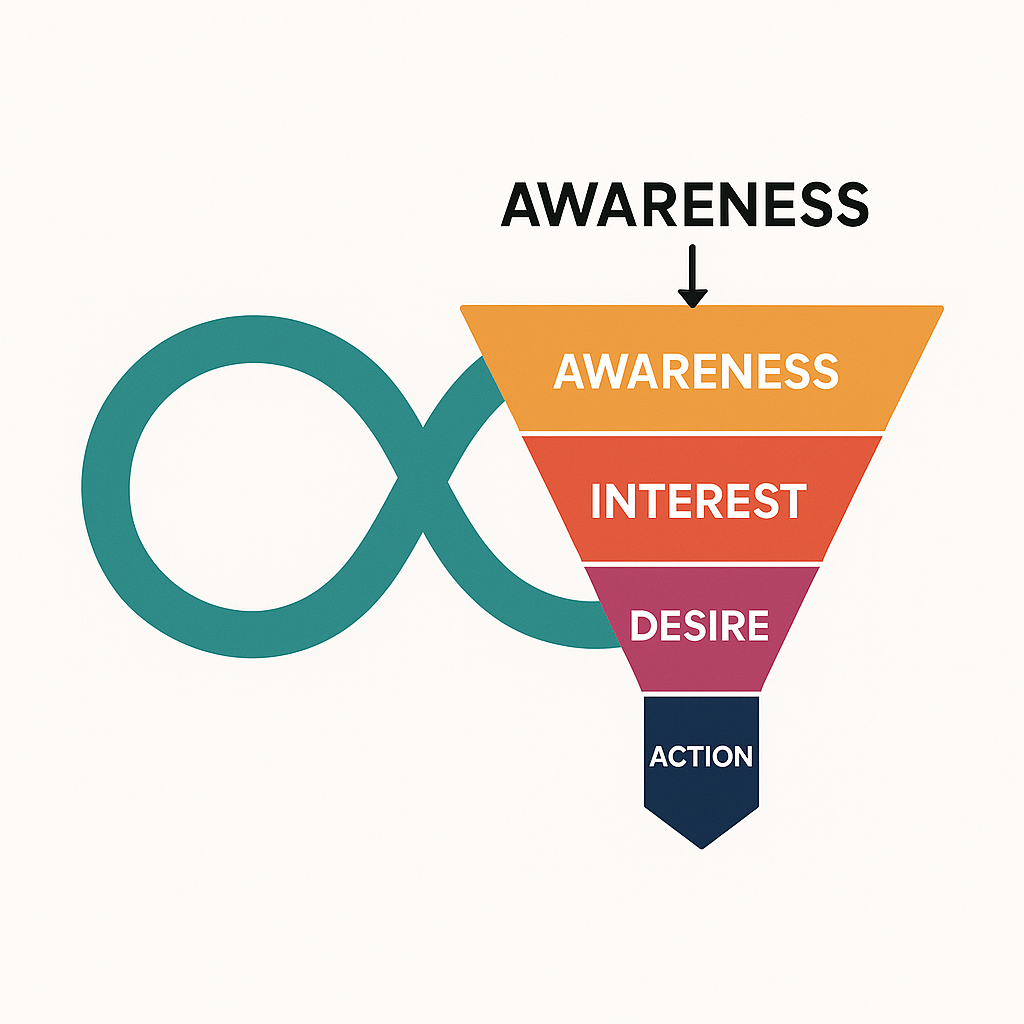
Marketing Funnels are Not Linear Anymore, Continuity has Entered
The time has come for marketing funnels. Well, they are not dying. But you cannot ignore the presence of elements impacting them and bending the linear path of the customer journey.
Marketers worship AIDA (Awareness, Interest, Desire, Action), the foundation of the marketing funnel. It is clean, predictable, and comfortingly neat. However, digital enlightenment has altered the path into official obsolescence.
AI, real-time personalization, and a never-offline, always-scrolling consumer base have opened up the customer journey.
It’s no longer about guiding someone down a straight line but staying visible across a tangled web of channels, touchpoints, and spontaneous decisions. It’s real-time. It’s algorithm-fed. Micro-moments, AI agents, and digital whispers across screens rule it. If brands don’t show up in these moments, with context, speed, and relevance, they’re out of the game.
Let’s deep dive into today’s customer journey, where funnels are loopy and dynamic.
Disruption in marketing funnels due to comparison, quick clicks, and easy data
The customer journey has lengthened over the years. The reasons? Today’s customers don’t just see and buy. They open ten tabs, scroll TikTok for unboxing videos, hop on Reddit for brutally honest reviews, ask ChatGPT for a roundup, and then decide.
The constant obsession with comparison has become a significant element behind the evolution of marketing funnels.
Everyone’s a micro-researcher now. Obsession is the new default.
Research needs backup. And, thanks to LLM (large language models) and intelligent search, users have instant, infinite, and conversational data search options. Brands are compared at hyperspeed, and one negative review or slow-loading site can instantly knock you off someone’s consideration list.
Quick clicks are another aspect of the customer’s journey where they don’t have to wait to shop. They can tap a QR code on a CTV ad, buy directly from a product placement on YouTube, or add to cart while watching a livestream. Retail media networks push personalized promos mid-scroll; even your smart fridge might suggest a grocery top-up.
Digital channels behind the reshaping of the customer journey
Passive channels, such as TV, digital platforms, billboards, digital ads, and even shopping at Walmart, have turned out to be active channels for customers. Awareness and action now live in the same frame. You see it, like it, and click—no detour through Google or social media required.
Retail media networks place ads right where decisions are made: in the search bar on Amazon, on sponsored shelves in Walmart apps, or as “related products” on your grocery checkout screen.
It’s not awareness. It’s not interest. It is straight-up ‘decide’ in real time. Brands are ambushing shoppers with precision offers and personalized nudges.
TV has gone from showing ads to shoppable ads. Connected TV lets viewers scan QR codes during shows, click on dynamic product placements, or shop directly from ads — all without switching screens.
That’s why you need to execute the omnichannel strategy.
Your customer could discover your product on TikTok, research it on Reddit, compare prices on Amazon, and finally buy it through a link sent on WhatsApp, all within an hour.
That means your brand can’t afford to go missing. It must appear on retail shelves, flash on digital billboards, speak in podcasts, pop up in CTV ads, and live inside their social scroll. Everywhere matters because everywhere connects.
Winning those micro-moments means integrating your data, messaging, and creative across every touchpoint. It’s one ecosystem, not five channels. When your digital ad talks to your retail media data, and your chatbot remembers what someone saw on Instagram, that’s when conversions happen.
AI in marketing is the engine that shapes the customer journey
Adobe predicted at the beginning of the year that AI would set the lines between real and unreal spaces. Experts believe we’re witnessing the dawn of a new chapter in search engine trends, where conversational results, like those from ChatGPT-powered searches, signal a monumental shift in how search engines, notably Google, reimagine their user experience.
We’re entering a world where AI doesn’t just assist customers, it acts on their behalf. AI can track preferences, anticipate needs, and deliver hyper-targeted experiences.
From autofill to AI-powered chats to personalized product pages that update in real time, AI quietly removes every hurdle between curiosity and conversion.
It shortens the journey, smooths the bumps, and meets people exactly where (and when) they’re ready to buy.
Rebuilding the marketing funnel with new elements
Like we stated before, AIDA or marketing funnels are not dead. Marketers must rebuild their funnels and strategies around them, keeping AI and a dynamic digital landscape in focus.
The problem with AIDA is that it assumes attention is sequential, decisions are rational, and influence flows in one direction or another. We’re no longer looking at a funnel; we’re looking at a loop powered by AI and built around feedback, speed, and constant learning.

Attention stays the same, but with a heavy touch of personalization. According to Amazon, Artificial intelligence is becoming a central force in advertising, streamlining processes, enhancing personalization, and driving better engagement.
Interest is replaced with interaction. Building engagement cannot be passive. AI enables two-way discovery via chatbots, voice, AR, and social, shifting users from browsers to active participants.
Conversion remains the same, but frictionless. The “desire” and “action” stages blur into one click.
The significant shift is at the end, where we see continuity, not just awareness. AI fuels post-conversion journeys. Every purchase feeds on better recommendations, retargeting, and loyalty strategies. The journey doesn’t end, it recycles and improves.
Spotify and Netflix are real-life examples. They build attention and continuity using recommendation engines that keep users engaged and returning.
Today’s journey is hyper-personalized, always on, and shaped in real time by data, behavior, and intelligent systems. Marketers can’t afford to think in steps; they must think in loops, signals, and moments.
Cut to the chase
The customer journey isn’t limited to marketing funnels anymore — it’s a choose-your-own-adventure powered by algorithms. The classic linear path from awareness to action has been replaced by a fluid, reactive, and constantly evolving journey.

